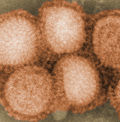 Every year the winter months see a surge in cases of seasonal flu which has a significant impact on public health and health services.
Every year the winter months see a surge in cases of seasonal flu which has a significant impact on public health and health services.
Most people recover within a week or two but vulnerable people – such as the very young, the elderly and those with a serious medical condition – can suffer serious complications. In some cases, infection can lead to pneumonia and death.
The European Centre for Disease Prevention and Control (ECDC) says surveillance and immunisation are key to protecting Europeans against seasonal influenza.
Video: What drives flu vaccine uptake?
Annual flu epidemics affect between 10% and 20% of the population every year, leading most developed countries to embark on immunisation ahead of flu season.
In 2009, the WHO declared the first full-scale influenza pandemic in decades after a new strain of flu – known as H1N1 – spread across continents. A vaccine against this form of influenza has since been incorporated into the annual flu shot. [Click here to read more about influenza]
How is vaccine composition decided?
The composition of the vaccine is worked out every year by experts at the World Health Organisation (WHO). The WHO recommendation is usually taken up by health authorities across the world.
According to Prof Bruno Lina, Professor of Virology at the University of Lyon, national reference centres play a key role in determining the make-up of the vaccine.
He told Vaccines Today that changes to the composition of the vaccine are necessary because influenza can quickly transform itself in order to evade the body’s defences.
“The body builds up immunity to viruses but influenza is an RNA virus meaning it can adapt itself and escape the immune response. The viruses can change proteins in a way that makes it difficult for the body to recognise them,” he said.
“So, if you want to protect people you need to have an optimised vaccine that contains the latest viruses that are circulating.”
Two winters, two vaccines
The WHO consults its network of influenza surveillance centres twice a year – once to help decide on the composition of the vaccine for the northern hemisphere, and once to decide on which viruses people need protection against in the southern hemisphere.
The seasonal vaccines given north and south of the equator are usually similar but can differ slightly given the pace with which flu viruses mutate.
“Every six months we have an opportunity to change the composition of the seasonal influenza vaccine. Sometimes there are no changes – this year the northern hemisphere and southern hemisphere vaccines are identical and with no changes from last year – but other times new strains emerge which must be included,” Prof Lina says.
The majority of EU countries are falling short of European targets for uptake of the seasonal flu vaccine. Indeed in 2009, the EU already recommended countries to ensure that 75% of their elderly population and 75% of people with some specific underlying health problems are vaccinated every year against seasonal flu. This, say experts, is partly due to misconceptions around the safety and efficacy of the influenza vaccines.
Health authorities and academics say the vaccine is safe and effective, and warn against complacency.




Emely Mills (@emelymillswater)
October 25th, 2011
http://t.co/cxQ5YP8n Seasonal influenza: an annual health threat | Vaccines Today
Emely Mills (@emelymillswater)
October 25th, 2011
Seasonal influenza: an annual health threat | Vaccines Today http://t.co/cxQ5YP8n
VaccinesToday (@VaccinesToday) (@VaccinesToday) (@VaccinesToday)
November 28th, 2011
Seasonal influenza: an annual health threat http://t.co/Qm8Re6O9 via @vaccinestoday